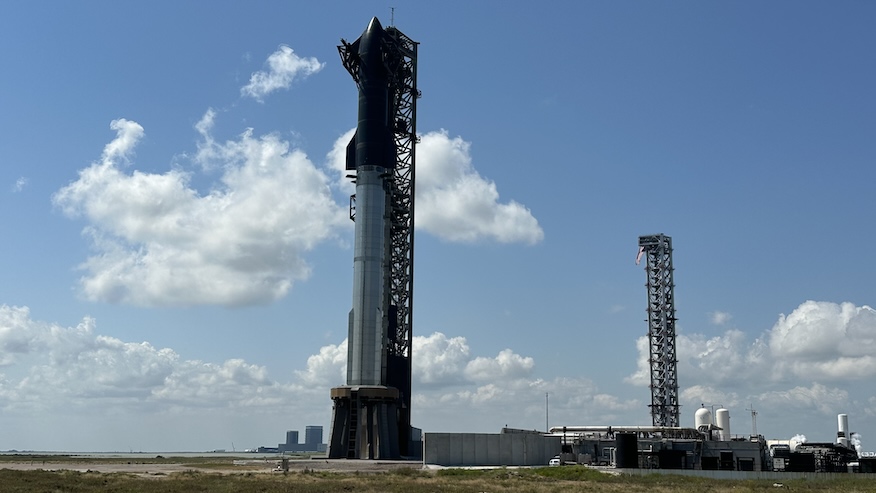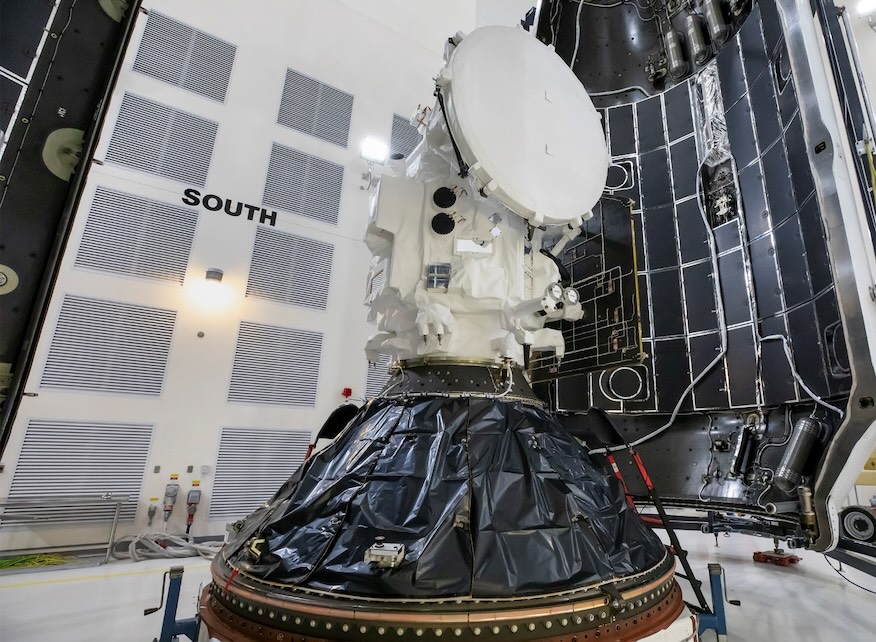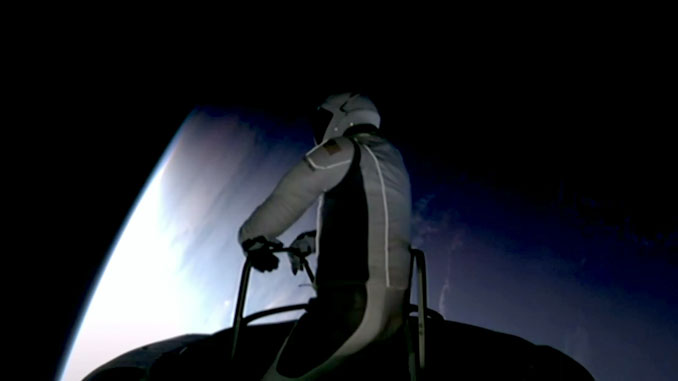
Update 4:00 a.m. EDT: Because of poor weather off the coast of Florida, Crew Dragon Endeavour will not undock from the International Space Station on Sunday, Oct. 13. A new undocking date will be determined
SpaceX is preparing for the fifth test launch of its massive Starship rocket from southern Texas Sunday morning. The mission, dubbed Flight 5, is headlined by the intention to catch the rocket’s Super Heavy Booster for the first time.
If all goes well during the initial ascent, the 71-meter-tall (232 ft.) booster will flip after separating from the Starship upper stage, fly back towards the launch tower along Boca Chica Beach and hover long enough to be caught by the tower’s robotic arms, called “chopsticks.”
Liftoff is set for 7 a.m. CDT (1200 UTC), the start of a 30-minute launch window. Spaceflight Now will have live coverage of Starship Flight 5 beginning about two hours prior to liftoff.
The Federal Aviation Administration (FAA) cleared the way for SpaceX to launch the mission when it issued a modification to its launch license on Saturday afternoon.
“The FAA determined SpaceX met all safety, environmental and other licensing requirements for the suborbital test flight,” the agency said in a statement. “The Flight 5 mission profile involves launch of the combined Starship/Super Heavy vehicle from Boca Chica, Texas, a return to the launch site of the Super Heavy booster rocket for a catch attempt by the launch tower, and a water landing of the Starship vehicle in the Indian Ocean west of Australia.”
By sheer coincidence, the launch was scheduled to happen within an hour of another critical SpaceX operation alongside NASA: the undocking of the Crew Dragon Endeavour from the International Space Station. The maneuver is designed begin the return trip for the Crew-8 quartet, a flight that was delayed due to poor recovery weather around Florida in recent days.
Dragon was set to undock from the space station no earlier than 7:05 a.m. EDT (1105 UTC). However, due to poor weather conditions off the coast of Florida, NASA and SpaceX decided to stand down from the opportunity on Sunday.
The launch from Starbase is also one of two suborbital rockets targeting liftoff from Texas on Sunday. Blue Origin is gearing up for another launch attempt for the latest, uncrewed launch of its New Shepard rocket near Van Horn, about 760 miles (1,223 km) from Starbase.
The NS-27 mission is targeting launch at the start of its window at 7:30 a.m. CDT (1230 UTC). If New Shepard lifts off on time, the Starship upper stage will be about 20 minutes away from concluding its coast phase and beginning reentry towards a splashdown in the Indian Ocean.
To catch a booster
SpaceX’s goal of catching the Super Heavy Booster, tail number B12, is an important piece of the company’s plan to rapidly reuse the rocket. In the days leading up to the planned launch, leadership within SpaceX publicly expressed their optimism that a catch will be possible.
“We landed with half a centimeter accuracy in the ocean, so we think we have a reasonable chance to go back to the tower,” said Bill Gerstenmaier, the vice president of Build and Flight Reliability for SpaceX during a presentation before the National Academies’ Committee on Biological and Physical Sciences in Space on Oct. 9.
That said, SpaceX will pull the plug on attempting to catch the booster, if it feels like conditions are not right during the rocket’s ascent.
“Thousands of distinct vehicle and pad criteria must be met prior to a return and catch attempt of the Super Heavy booster, which will require healthy systems on the booster and tower and a manual command from the mission’s Flight Director,” SpaceX wrote. “If this command is not sent prior to the completion of the boostback burn, or if automated health checks show unacceptable conditions with Super Heavy or the tower, the booster will default to a trajectory that takes it to a landing burn and soft splashdown in the Gulf of Mexico.”
The return of the Super Heavy Booster will also likely be accompanied by a sonic boom. The reverberating noise is something that launch viewers near both Cape Canaveral Space Force Station and Vandenberg Space Force Base have witnessed numerous times, but the phenomenon will be a new experience for those in the Rio Grande Valley.
On Saturday, a day before the launch, SpaceX issued an advisory to the public in Cameron County, alerting them of the event, which would only happen if SpaceX decides it is comfortable moving forward with a catch attempt of the booster.
“A sonic boom is a brief, thunder-like noise a person on the ground hears when an aircraft or other vehicle in the area flies faster than the speed of sound,” SpaceX explained. “The sonic boom does not present a health risk and what people experience will depend on weather and other conditions.”
The reference to “health risk” ties back into what was an ongoing back and forth between SpaceX and the FAA while the launch license modification was under consideration. During an unrelated congressional hearing on Sept. 24, FAA Administrator Mike Whitaker responded to the questions related to Starship Flight 5 in which he asserted that “the sonic boom analysis is a safety-related incident.”
In a letter to Rep. Kevin Kiley, a Republican representing California’s Third Congressional District, SpaceX pushed back on those comments, arguing that the administrator was factually mistaken. The company argued that the sonic boom was a not “related to public safety, but to environmental considerations that had been previously evaluated as posing no risk to the environment.”
Returning the booster after launch is a core capability to Starship becoming rapidly and reliably reusable pic.twitter.com/j4NSdnNiKr
— SpaceX (@SpaceX) June 27, 2024
In the Oct. 12, 2024 Written Re-evaluation of the 2022 Programmatic Environmental Assessment (PEA) for the SpaceX Starship/Super Heavy Launch Vehicle Program document, it describes the need to update the model of impact for the sonic boom.
“The increased area in the sonic boom contours results in a larger potential impact area for these resources, however applicable resources in this expanded area are appreciably similar to those already discussed,” the document stated. “Accordingly, the 2022 PEA remains valid documentation of the affected environment for the Proposed Action.”
The document goes on to state that “Pursuant to FAA-required insurance, SpaceX will continue to be responsible for claims of structural damage due to events such as sonic booms, if any such damage occurs.”
If the booster is successfully caught by the chopsticks, SpaceX will need to offload the remaining propellant from B12. The timeline for the process will be finalized once SpaceX has a health assessment of the booster and determines the best means to safe the vehicle before crews are able to access the area around the pad again.

Water deluge concerns alleviated
Another sticking point in the lead up to authorizing the Flight 5 mission concerned SpaceX’s water deluge system, the method by which SpaceX dampens the impact of the 33 Raptor engines as they lift the rocket off the Orbital Launch Mount.
There was concern raised regarding SpaceX’s compliance with the Clean Water Act, which came to the FAA’s attention on Aug. 9.

“SpaceX sought coverage for the deluge water discharges under the Texas Multi-Sector General Permit administered by [Texas Commission on Environmental Quality] in July 2023,” the FAA wrote. “However, as addressed in a March 13, 2024 Administrative Order (AO) issued by the U.S. Environmental Protection Agency (EPA) and an August 2, 2024 investigation report by TCEQ, the EPA and TCEQ found that prior deluge water discharges were not permitted and thus violated the Clean Water Act (CWA) (33 U.S.C. § 1251 et seq.) and Texas environmental quality and water control laws (30 TEX. ADMIN. CODE § 305.42(a) and TEX. WATER CODE § 26.121(a)(1)).
“The agencies found that SpaceX must apply to TCEQ for an individual Texas Pollutant Discharge Elimination System (TPDES) permit covering water discharges. SpaceX submitted a permit application on July 1, 2024 and has since entered into agreements with TCEQ and EPA to resolve the alleged violations.”
The FAA noted that SpaceX and the EPA entered into a consent agreement and final order (CAFO) on Sept. 5 and on Sept. 12, the EPA wrote a letter to SpaceX noting that SpaceX met its obligations and the matter “is hereby closed.”
NASA eyes mission developments
While Starship Flight 5 is an entirely SpaceX operation, it’s being watched with keen interest by NASA and especially its Human Landing System program office. A variant of Starship will be used during the Artemis 3 and Artemis 4 missions, which will ferry astronauts to and from the surface of the Moon.
Prior to launch, Dr. Kent Chojnacki, the deputy manager of the HLS office, told Spaceflight Now that he and his colleagues were “very interested” in how well both the Starship upper stage and the Super Heavy Booster perform. He said in particular, they will be watching the attempt to catch the booster.
“What’s interesting to us about that is, for the architecture that SpaceX has proposed and is implementing, they’re going to have to do several launches in order to aggregate propellant in low Earth orbit prior to going to the Moon,” Chojnacki said. “Being able to rapidly reuse the boosters demonstrates that cadence.”
The architecture he referred to involves SpaceX launching a tanker version of Starship that will remain in low Earth orbit. Multiple ships will be launched to dock with it and offload propellant for storage until there’s enough to transfer into the HLS version of Starship that will receive its crew in lunar orbit.
Chojnacki said SpaceX will need to launch on a roughly biweekly basis in order to fill the depot in an efficient manor. Eventually, SpaceX will call upon the use of a launch tower under construction at Launch Complex 39A at NASA’s Kennedy Space Center as well as the two towers at Starbase.
“Operations where you’re launching maybe once a week out of each pad, so that each pad has a two-week turnaround, but you’re launching about on a weekly basis to go up, fill the depot, come back and reuse those boosters and tankers to get that operation,” Chojnacki said. “That’s the kind of cadence that would be great. We don’t really know what the boil off is. Some of the early flight experiments that we’re looking for is that data to understand what that curve would look like.”
SpaceX proposed a propellant transfer demonstration as a development milestone to NASA, which is anticipated in early 2025. Chojnacki said they would just use the two towers at Starbase for this demonstration.
“The current date on the schedule would be March of ’25 to start that campaign,” Chojnacki said. “So, we’re hoping the first half of ’25 to be able to see that work.”
Chojnacki said given the known work ahead of them, they don’t anticipate being the limiting factor to the Artemis 3 mission being able to launch in September 2026.
“That is definitively the date we’re working towards. We don’t have any known roadblocks,” Chojnacki said. “We do have some first time things that have to be demonstrated and we have a plan in place to go demonstrate those.”


